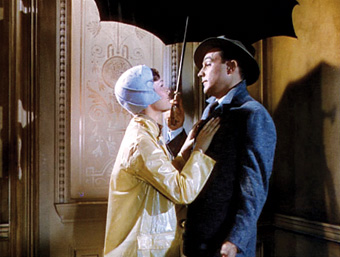 | 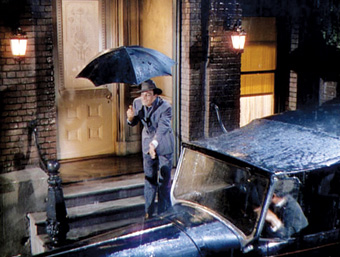 |
| 1 - The sequence starts with Gene saying good night to Debbie Reynolds at the door. Musical pictures are not like anything else because they include a stylistic device. If there were rules and regulations, everybody could do it. Somebody said, 'It must be fun making these pictures. And I said, 'Fun? It's torture. It's worry. It's anxiety. It's conflict, argument, indecision.' It's not fun. The only fun is looking at it after. Gene was very tough on himself and everybody else. He was very definite about how he wanted to do it. We were [lucky] that we had him; there's nobody who could have expressed it the way he did. This was just perfect for his gifts and talents. | 2 - To make the rain, there had to be big stretches of pipes with holes in them, and water pressure. You had to control from the valves how much pressure you put into the pipes, just like in your bathroom. We had a funny kind of trouble, though, in that we were at MGM in Culver City, and it was a hot summer, so what would happen is that at 4:30 or 5 in the afternoon, when the sun was starting to go down, the people of Culver City watered their lawn, which made us lose water power. So every afternoon between 4 and 5, we had to stop, because there wasn't enough pressure to make rain. We had to work with the reality of life. |
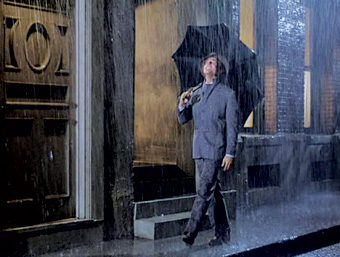 | 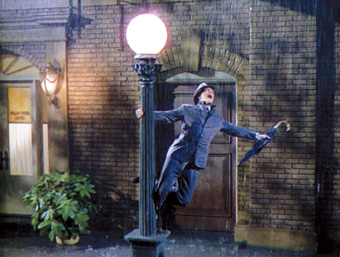 |
| 3 - Before the song starts, Gene walks along the sidewalk to a vamp written by Roger Edens. It was an example of what we used to call 'sneaking in' the music. There was no orchestra. It wasn't in a rehearsal hall. You had to make the audience not realize there was music happening, because it's not real, it's not life, it doesn't relate to what's happening in the world we live in. It's the hardest moment in my experience, that moment when the artist goes from the way we live−talking−to the point where they start to sing. It's really delicate, so you have to 'sneak' it in. | 4 - By now he's started singing. Only once in my entire life have I filmed a song performed live, because it was almost impossible to lip-sync back, and that was only a song, not a dance. But the best solution is to pre-record it, like we did here, and play it back. The way it works is you rehearse your ass off till you get it as good as you can, and then record the sound and music, then sing it, then put the playback on when you're going to shoot it so the artist can lip-sync to the track. It's harder if you try it the other way, because if you have the orchestra on set, you've got to post-sync. You've got to match the takes. So the best of the worst of problems is to pre-record. |
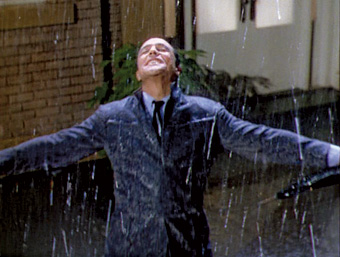 | 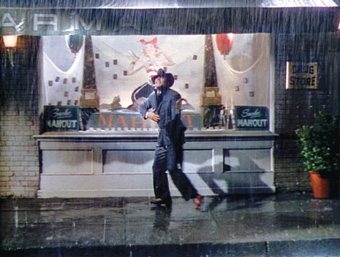 |
| 5 - You can't think of a camera angle before you know what you're doing. You work out the choreography, then you wonder what the best way to show it is. So here, he's singing, 'Come on with the rain, I've a smile on my face.' Because that's what's happening at that moment, I moved in on his face so you can see the smile, and the rain. When you're shooting rain, it has to be backlit, or you may not see it very well. There have been a lot of stories about how we put milk in the water so you could see the rain. It's not true. You have to put the light behind the rain so that the raindrops show. If you put the light in front of the rain, with no light behind it, the rain disappears. | 6 - In order not to give Gene pneumonia−because that was a consideration−we would do the take, he'd be drenched wet in a wool suit, and then he would take off the suit and dry out. Then we'd get ready and relight for another shot, if we got the shot we needed. Chances are we did get it, so he'd have an hour and a half, two hours before he'd be due. We must have had two or three suits, and we had a warm room to hang them in to dry. |
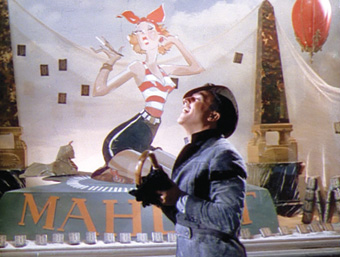 |  |
| 7 - We decided he'd flirt a little bit with a picture of a girl to show he's happy, so we put that display in. The window was already there. This was all on MGM's backlot. It was the street. Gene and I hated sets because we wanted to do it in reality. So the problem was making it as close to life as you could, and not make it look like the fake fronts of buildings. The lot was literally outside, but we shot it in the daytime. We had to put a tarpaulin over it to make it dark, and then light it as though you were shooting at night. So we were shooting at night, but it was our night, not God's night. And because it was a hot summer in L.A., working with rain inside a black tent made it hotter than hell. | 8 - We could only do a couple of takes for each shot. Gene and I didn't really have any disagreements about the takes. Nowadays, everything is printed, so you see it all. But in those days, you were only allowed to print two takes, and only photograph five. This was wartime and after that. You had to be sure it was right. We'd do rehearsals before we rolled film, and the artist wouldn't perform quite as hard, because he or she didn't want to be exhausted. It wasn't a small crew, either, because everything had to be done manually. Panning the camera, tilting it, pushing the boom. There was no remote-controlled anything. |
 | 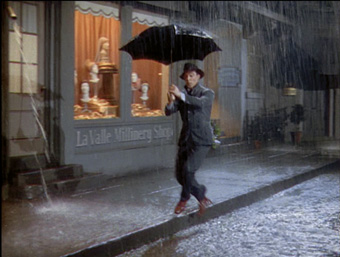 |
| 9 - There's almost no improvisation, no room for that in a musical sequence. You can't change it. It's fixed. It's hard. It's recorded. He's got to get from A to B to C to D exactly in time. The accidents happen in rehearsal. So we rehearsed for six months, but we never quite got the rain from the spout to hit at the exact place when he goes under it. He's a tiny bit late getting into the right position. But not to complain. It's 57 years later. We were quite happy. | 10 - We filmed in Technicolor. There were some physical problems because you needed an enormous amount of light in those days, compared to what we do today. The film was slow, and the lenses were not as fast, so you needed huge amounts of light. It took a long time to organize the lights because there were so many of them, and they needed constant attention. They were arc lights; they weren't incandescent. So you had to trim the arcs. Everything has got to be controlled, and everything is. It's not a documentary. It's the antithesis of a documentary. |
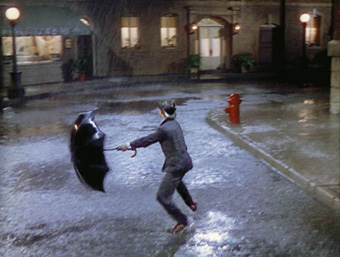 | 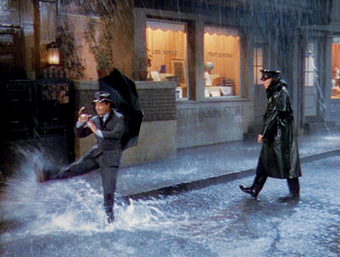 |
| 11 - Gene loved the umbrella. It was the prop that helped express the number. It was a hard prop in some ways. It's clumsy when it's open, but it's not open that much in the number. The whole idea is that it's down. It's about singing in the rain. It's how he wants to feel the rain. Musicals are a combination of acting, singing, dancing and entertaining. It's everything playing at once. It's not like acting where you're trying to really show the truth. | 12 - Choreographing dry is certainly easier than choreographing for rain. But it wasn't a problem. We imagined all these things, and then choreographed every instant. All the things that look like they just happened, didn't. They were planned. So when Gene splashes in the water, we had to dig holes in the cement to make a place where he would stamp. The dance step had to take him to that place on that note, so it's very detailed. |
 | 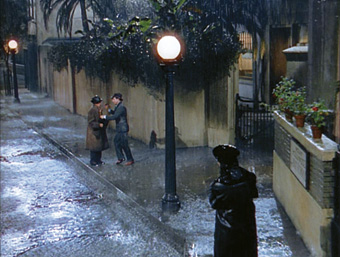 |
| 13 - Gene is embarrassed by the policeman because he's like a kid playing in the water. As for the policeman, I'm not sure, but when I see it now, I have a feeling that somewhere in my head it came from Chaplin. I was such an admirer of Chaplin's sequences, and policemen were always interfering. This is the first time I cut to the point of view of another person. I think it was just a way of saying, see what's happening here, this is what he does, is that interesting? | 14 - Here at the end, he gives the umbrella away to a man who's very happy to have it. We shot this whole sequence in maybe two and a half or three days. There aren't a lot of setups. It's very spare. But that's generally how I like to do it. I want the viewer to believe that it's happening, and that there's nobody in charge. When the technique of making the movie becomes a part of the movie−and there are people who do it wonderfully−then you're not going to have Fred Astaire or Gene Kelly. You're going to have Federico Fellini. I wanted, 'Oh, he just got up and did it, and they photographed it.' That's how it should look. |